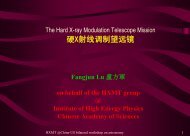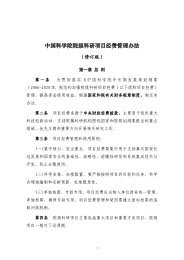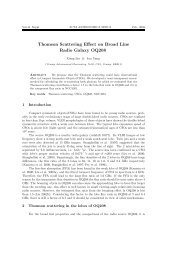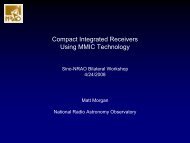Project FAST- Five hundred meter Aperture Spherical radio Telescope
Project FAST- Five hundred meter Aperture Spherical radio Telescope
Project FAST- Five hundred meter Aperture Spherical radio Telescope
You also want an ePaper? Increase the reach of your titles
YUMPU automatically turns print PDFs into web optimized ePapers that Google loves.
Neutral hydrogen (HI) surveyCosmic history is written in the characters of weakHI line emission. To read this encyclopaedia, a supersensitive telescope is requiredBlind detection of HI clouds with an interference-freeobserving period of 1h, z~0.7Warm HI shell around AGN, the detection range limitin a moderate integration time, z~35
Kravtsov - Simulation ondark matter distribution in anormal galaxyXuelei Chen –Estimated<strong>FAST</strong> detection sensitivity of1 min & 1 hLine width 30km/s,S/N -106
Duffy et alNumber of galaxiesto be detected perday (18h) using<strong>FAST</strong> 19 beamswith different sanrange---- 6 sec---- 60 sec---- 600 sec---- 6000 sec---- 60000 sec7
<strong>FAST</strong> Pulsar SurveyThere are ~ 6 X 10 4 detectable pulsars inthe Galaxy, half is in <strong>FAST</strong> sky~10 4 pulsars• Rare objectsExotic stars – quark matterPulsar-BH binary….• Stellar evolution before SN• ISM map of unprecedenteddetails8
A ‘master’ of VLBI networkBonn100Chinese station<strong>FAST</strong>VLBA 80 μJyHSA 5.5 μJyHSA+<strong>FAST</strong> 3.1 μJyMuch longer source on timeIf <strong>FAST</strong> joined VSOP-ground VLBIEquivalently a 100 m in space9
Early sciences with <strong>FAST</strong>– bilateral meeting in JBO• HI – small scale deep survey of H-z• Pulsar – BH binary• M31 – extragalactic pulsars• Survey more pulsars in clusters, more about this by Scott• OH masers at z ~ 1• Lines in Orion e.g. C20H10 ? By DiFollow-ups of LOFAR/ASKAP ….Make use of the whole 500maperture by adopting a longlinear feed to achieve ?10
2. General Technical Specification<strong>Spherical</strong> reflector:Radius~300m, <strong>Aperture</strong>~500m, Openingangle 110~120°Illuminated aperture:D ill=300mFocal ratio:f/D =0.467Sky coverage:zenith angle 40°(up to 60°with efficiencyloss) tracking hours 0~6hFrequency:70M ~ 3 GHz(up to 8GHz in future upgrading)Sensitivity (L-Band) :A/T~2000, T~20 KResolution (L-Band) :2.9′Multi-beam (L-Band) :19, beam number of future FPA >100Slewing:
★ S 2★ S 1Optical geometryO12
Opening angle - sky coverageSky coverageZA 30 degZA 40 degZA 60 deg<strong>FAST</strong> ZenithZA 56 degSky coverage<strong>FAST</strong> vs. Arecibo13
Opening angle - sky coverage (cont.)300mZA205m30º 60ºIf FPA technology could form an irregular beam tofully match the desired portionWe can have a large single dish ~ 200m at zenith 60°We are interested to have the Roger’s talk on FPA14
Frequency range0.13 0.327 1.42 3458(GHz)In layout 2000First phaseSecond phaseHI surveying70MHzz~20EoRPulsar300MHzHCOOHCH3OH OH(4) HC5N(4) CH(4) CH4Water hole5.2GHzH2CO(6)VLBI17 LinesSETIS BandC BandX BandSpace science15
ObservatoryObservatory buildingComputing centerDisaster prevention3.Technical plan– critical technologyReceiversReceiversBackendOptical fiberMeasurementsMark stoneLaser total stationPhotogrammetryField busSiteActive ReflectorFeed supportMeasurementsReceiversObservatoryEarth workDrainageExplorationSiteTension monitoringWinchesElementsMain cable netActive ReflectorCablesAB-rotator & StewartCapstanTowerFeed support 16
3.Technical plan– critical technologySiteActive reflectorFeed supportMeasurementsReceiver17
Site Surveying in GuizhouGuiyangLocation: N25.647222ºE106.85583°Site: the Karst region in south Guizhou Province18
Quick Bird Fly Oct. 6, 200519
3.Technical plan– critical technologySiteActive reflectorFeed supportMeasurementsReceiver20
Central part of sphere is close to paraboloid as f/D is properMinimized deviation is 0.67m as f/D ~ 0.467 RMaximum slope of deviation curve gives maximum rate 0.7mm/sdeviation along radial direction (<strong>meter</strong>)1.61.20.80.400.40 20 40 60 80 100 120 140 160distance from center of aperture (<strong>meter</strong>)F=0.467RF=0.477RF=o.450RMain reflector is composed of small element units~ 2000 hexagons of 15m – rms 4mm~ 4600 triangles of 11m – rms 2.2mm21
~2400 winches~4600 panelsAdaptive cable-meshTwo realizationsof main reflectorSolid panel-actuator~2000 panelsandactuators22
3.Technical plan– critical technologySiteActive reflectorFeed supportMeasurementsReceiver23
Feed supportmechanical-electronic-optical integrated design• Focal cap dia<strong>meter</strong> 206m• Cabin in total ~30t• Load on lower plate ~3t• Maximum tracking 11.6mm/s★ S 1• Slewing 400mm/s• Position error
Three main parts of cabin suspension• Cable network - first adjustable system• Stewart - secondary adjustable system• Close loop control25
3.Technical plan– critical technologySiteActive reflectorFeed supportMeasurementsReceiver26
Measurement – precise, quick and in long distanceTask 1: 3-D spatial positions of focus cabin• Large working range up to 300 m• Errors ~1 mm• Sampling rate > 10 HzTask 2: profiles of main reflector• Number of targets ~2400• ~1000 in illuminated area• Accuracy 1~2mm• Sampling interval 10 sec ~ few min27
PhotogrammetrySurveying reflector profile1000 nodes withinilluminated areato be scanned in real-timeperiod ~ 1 min28
3.Technical plan– critical technologySiteActive reflectorFeed supportMeasurementsReceiver29
9 sets of <strong>FAST</strong> receivers NAOC - JBONo Band (GHz) Beams Pol. CryoTsys(K)1 0.07 – 0.14 1 RCPLCP2 0.14 – 0.28 1 RCPLCP3 0.28 – 0.56 1 or multi RCPLCP4 0.56 – 1.02 1 or multi RCPLCP5 0.320 – 0.334 1 RCPLCP6 0.55 – 0.64 1 RCPLCP7 1.15 – 1.72 1 L wide RCPLCP8 1.23 – 1.53 19 LnarrowmultibeamRCPLCP9 2.00 – 3.00 1 RCP/LCPno1000no400no150yes60no200yes60yes25yes25yes25ScienceHigh-z HI(EoR),PSR, VLBI, LinesHigh-z HI(EoR),PSR, VLBI, LinesHigh-z HI(EoR),PSR, VLBI, LinesSpace weather, Low frequency DSNHigh-z HI(EoR),PSR, VLBI, LinesExo-planet scienceHI,PSR,VLBIEarly sciencesHI,PSR,VLBIEarly SciencesHI,PSR,VLBI,SETI,LinesHI and PSR survey, TransientsPTA, DSN, VLBI, SETI30
Receiver -- Schematic DiagramFeed+ polarizerLNA Mixer E/OO/EHIlinePulsarVLBISETImultiReceiverDiagnostics31
4. Feasibility study of critical technologiesFeasibility study of critical technologies started since 1994.More than a <strong>hundred</strong> scientists and engineers from 20 institutionsThe project is ready to move on to actual programming.• Fast sciences• Site surveying• Active main reflector -- Solid panel-actuator design- Adaptive cable-mesh design• Feed support- Cables + stabilizer- Cables + rotation mechanism + stabilizer• Measurement• Receiver32
Exploration in depression site and therock-soil samples from ground33
eaking load experimentcablesnodes34
Prototyping the back-structureof reflector elementSimple, enable mass production, strong weather resistance.10kg/m 2 is a up-limit边 缘 构 件bowstring刚 性 构 件Rear rib: hollow rectangular tube, Z-shaped …Spatial truss backup (costly)35
Prototyping rear ribLess than 1mm curved, gravity – no gravityjoint Adjust screw Bow-stringSingle rear ribSingle rear rib with bow-string36
Spatial truss backup (costly)Deformation 2.5mm by gravityAdjust screwjointExpandedaluminum meshPerforated aluminum sheetSpacial truss back structure37
Prototyping the winches• worm-wheel/ball screw• cycloidal-pin wheel /sliding screw• serial worm wheel/ball screw• cycloidal-pin wheel /worm wheel /sliding screw=830行 程 830拉 伸 长 =1215尾 销 端编 码 器 护 罩编 码 器 出 线 口联 接 法 兰收 缩 长 =385接 近 开 关日 本 减 速 电 机接 近 开 关 护 罩38
Prime focus position controlExperiment on the cable39supporting system, Dec. 2001
Dynamic experiment on Stewart stabilizer, Sept. 200240
NCollaboration with MT and TUDOptimization of cable tension force:Max.: 220KN;Min.: 100KNDesign of counter-weights:travel range reduction: R=2rcounter-weight=[(220+100)/2]*2=320KN(100KN)motor gearbox bearingCapstan drum (R)Counterweightdrum(r)41
1st harmonic (0.182455Hz)2nd harmonic (0.4247Hz)Vibration modes and Bodediagram of suspension cables42
• under the wind 8m/s, 1st adjustmentreaches control accuracy 8mm• as the stabilizer is switched onaccuracy 4mm• spectra - 0.18HzTotal weight of cabin ~ 30treceivers 4Stabilized platform 2actuators 1,5X-Y Frames 4Y- positioner base 4cladding 8Top frame – star truss 4total 27,543
Most precise laser rangerAPIMaximum rangingdistance – 120mTCRA2003: 1+1ppmAPI: 0+5ppmADM-IFM error (mm0.5000.4000.3000.2000.1000.000-0.100-0.200-0.300ADM specaverageADM spec-0.4001.11.0#3449 Tracking ADM intensity-0.5000 10000 20000 30000 40000 50000 60000 70000 80000 90000 100000 110000ADM dis tance (mm)0.9ADM Intensity (V)0.80.70.60.50.40.30.20.1To expand the rangingReshape the beamNew detector – 150VAvalanche breakdown voltage0.00 10000 20000 30000 40000 50000 60000 70000 80000 90000 100000 110000ADM Distance (mm)44
CCD:20Hz;0.5cmDGPS:10Hz;1cmLaser Tracker:1KHz;0.05mmIMU:0.1°Measuring45Total station
Receiver layout• Main focus, -13dB, G/T ~ 2000 m 2 /K• 70MHz - 1GHz,4sets 1-octave band• L – one wide band receiver19 multi-beam receivers• 2 - 3GHz scaled JBO C - band1.23-1.53 GHz multi-beamATA 0.5 – 11GHzLOFAR 120 – 240MHzf - range :1.23-1.53 GHzfeed:19 coaxial hornsf/D: 0.46, less curved than ParkesLNA: HEMT cooledIF:optical fiber cabin - groundBackend:HIPulsarTransientsWSRT 115 – 180MHz46
<strong>FAST</strong> model construction process1. tower2. girder ring3. cementdepression5. actuator4. cable & node
HI was observed using 50mmodel in Sept 2006.48
5. Current state of <strong>FAST</strong> projectTotal budget ~ 688 millions ¥ (600 millions admitted)Budget in feasibility report is ~ 700 millions ¥<strong>Project</strong> time 5.5yrs from foundationBudget pie41%11%5%1%4%10%5%6%10%7%- Main reflector-Earthwork- Feed support- Receivers- Measurement and control- Infrastructures-Design- Observatory and facilities- Site investigation- Unexpected49
Approval appears on SKA webpagehttp://www.skatelescope.org/pages/page_newfront11.htm50
















